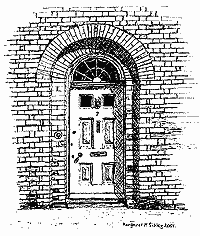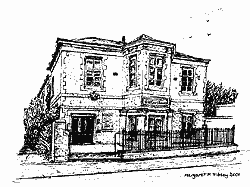![]()
Church Street, East Street and Cherry Street
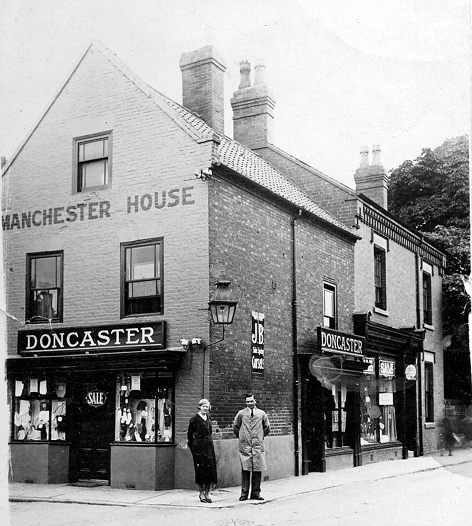
Doncaster's shop at the corner of Church Street and Market Place in the 1920s. Doncaster's was the clothes shop used by everyone in Bingham. Photo by permission of Freda Hayes.
|
The early 19C building on the
Market Place corner and its later extension (Nº1)
was Doncaster's
(above) drapers for over a hundred years until the 1950s. The
Georgian White Lodge
(number 7) dates from the early 19C was built on the
site of a much older building and malthouse by the licensee
of the Chesterfield Arms, William Pilgrim. Doctors have
lived here continuously for over 150 years. The lead
guttering flush with the top of the wall is unusual.
The surgery entrance was the first door along the right
hand sidewall. The upper window to the west was designed
to allow air into the bedroom of a 19C doctor's consumptive
wife without admitting rain. The upper part of the window
is hinged at the top and when opened makes a seal with
the sidepieces. The garden wall along Church Street
is from about 1700. The 'oldest wall in Bingham', mid
18C and built of mud and brick topped with pantiles,
separates the garden from the school. The top of the
wall can just be seen from the street. |
|
||
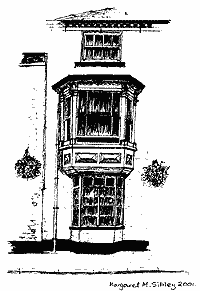 The Chesterfield Arms |
|
||
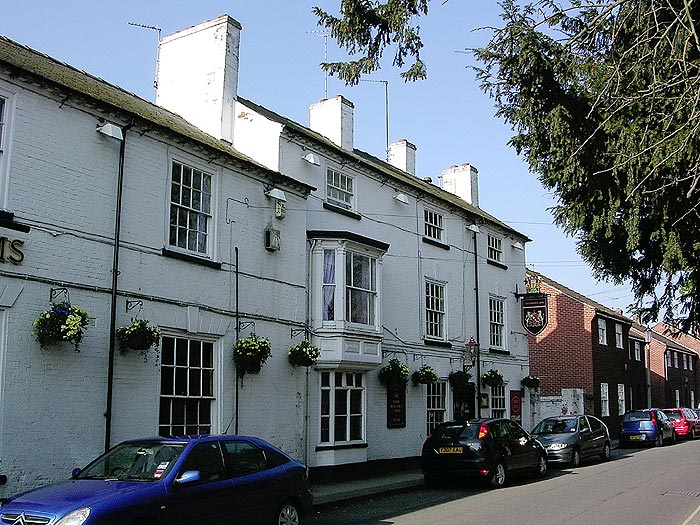
|
The archway between Nºs11 and 15 leads to a yard of 18C cottages with Victorian additions to the front. Amateur players used a barn here as a temporary theatre from 1783-5. Plans attached to the deeds for White Lodge suggest number 13 may have had an upstairs roof space accessed by outside steps making it a prime candidate for the precise location of the theatre. The narrow bricks and low rectangular windows of No13 date it to around 1750. It was a school in the 1920s. Nºs15a and 15b formed a bakehouse to the rear of the shop. Nºs 17/19 are from the 1860s, but wrap around a late 17C cottage to the rear of Nº19. Nº21 is late 17C or early 18C and was thatched. Nearly derelict it was refronted in the mid 19C but the rear is original. This plot was owned by the Earl of Chesterfield. In 1895 James Walker leased from the Earl of Carnarvon land with a large, possibly derelict, house and by 1897 had built The Victorian villas (Nos 8-14). As with other property in Bingham the freehold to number 12 (and quite probably the others) was sold in 1920. |
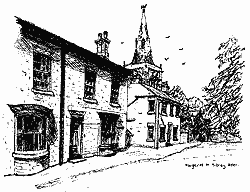 Church Street (East) |
From 1790 until about 1850 the post office was at 'Mr Strong's house in Church Street'. From what we know of the uses of the other houses that have been in Church Street, Seymour Cottage (Nº16) would seem to be the most likely location for the post office. Also, local folklore puts the post office here, although it may have been at the house demolished to make way for numbers 8-14. The cottage can be dated to about 1720 and from the steepness of the roof pitch would originally have been thatched. The rear portion is clearly a later extension resulting in a plan that is common throughout the country.
The cottage, No1 Church Lane, was much restored in about 1970. It is based on a terrace of three presumably agricultural labourers' cottages and for many years was used as a storeroom for No21. The remaining properties on Church Lane are on a long strip of land formerly attached to 21 Church Street - more 20th Century infill.
|
Church Street and East Street terminate so abruptly against the churchyard as to suggest they were once a continuous thoroughfare. The churchyard was extended over the line of the streets possibly as early as in about 1680 - the oldest legible gravestone is dated 1699, although it may have been moved. Sanderson’s 1835 map does not show a continuous street. The earliest parts of the Church of St Mary and All Saints are 13C and a good guide is available inside. Note the stone house martin above the porch. The Lych Gate is a 2001 restoration of the original designed by Canon Miles' son Frank, whose friend Lily Langtry often visited (Langtry Gardens are off Station Street). Canon Miles is said to have carved the inscription 'Through the Grave and gate of Death to our Joyful Resurrection'. Church House doorway to Master's House, Church House |
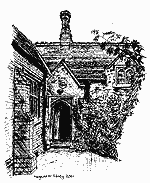 |
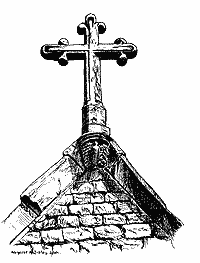 Church cross Stone Martin above Church Porch |
The cottage fronting the footpath that now connects the two streets is Nº2 East Street. It was the successor to the 18C rectory on the Robert Miles School site and was itself replaced by the new rectory alongside Church House in 1990. A previous rector reported that he encountered the remains of a thick stone wall when installing a damp proof course, which he said seemed to have been constructed of similar stone to the early parts of the church. One might speculate it is the remnants of a cottage the stonemason may well have used to be near the church. The Elizabethan style Church House in East Street was built as a school in 1845 by Canon Miles on 1218 square yards of land he had purchased from the Earl of Chesterfield. It cost £350 and was built by Samuel E Hill, according to a receipt found in Notts CC Archive dated November 28 1845. It is the most ornate building in the town. It is a classic example of mid Victorian exuberance in reviving the Elizabethan style, the 17C custom of using vitrified brick headers to produce diaper patterns on the walls and using a heavily decorated and ornamented patterned roof. The building repays a long look! It supplemented the first school on Long Acre, taking the boys only. Later the arrangements were rationalised so that infants went to Long Acre and older pupils went to the Church School. As the name implies there were orchards in Cherry Street. Nºs 1-5 were built in the mid to late 19C probably for estate workers. A fine example of a wood enclosed pump can be seen against the end wall of No5. An earlier terrace of south-facing cottages was end-on to the street just south of Nº5 and was still shown on the 1915 map. The rest was orchards and market gardens up the junction with Long Acre. Dane Cottage is early 19C; the single storey part was a watchmaker's shop, owned by Ted Johnson in the 1920s and before that had been a greengrocer's. The house was sold from the crown estate in 1966 and the rest of its land to the north was separately developed. The 1848 directory records George Huskinson as a baker in Cherry Street - Dane Cottage is the most likely site. Could it then have been Thomas Gilbert (1853) and John Walker (1864/5), boot and shoe makers? In 1853 there was also a fishmonger, John Goodwin, in Cherry Street, which illustrates the difficulty of interpreting directories! Further work with census information may help shed more light. |
The elaborate 1920s (Nºs 6-8) semis on the west, were designed by Cyril Walker Kendrick, former Rural District Surveyor. No 6 was for the chemist Mr Cadge; No 8 was for his own family’s occupation. These were built on former orchards, the 19C wall of which still borders the houses, but at a reduced height. Kendrick was very keen that people should be able to look out of their front room windows whilst seated, which explains the size of the windows and the reduction of height of the wall. Also in the 1920s Kendrick designed the first council houses in Bingham, in the triange between Tithby Road, Nottingham Road and Stanhope Way.
On the East Side is more infill from the 1950s and 60s.

